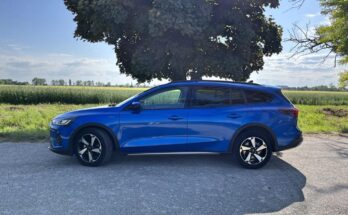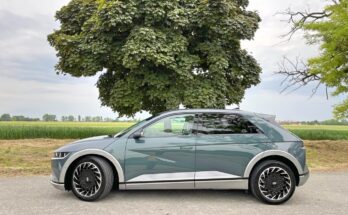Suzuki Vitara again changes the range of power units. New in the price list is the hybrid version, which works with the naturally aspirated 1.5, and according to the non-dazzling performance parameters, it will be a solid drive, especially for calm drivers. So let’s take a look at how this hybrid actually works.
First, let’s get some history and technicalities. The current generation of Suzuki Vitara has been on the market since 2015, and even last year, it was on the leading rungs of the SUV-B market segment. It entered the market with an atmospheric gasoline 1.6 VVT with 88 kW and a diesel 1.6 DDiS, also with an output of 88 kW. With the modernization in 2018, a liter three-cylinder with an output of 81 kW and a four-cylinder 1.4 with an output of 103 kW with the name BoosterJet (by the way, one of the best engines that the Vitara has ever received) were introduced. Shortly after that, the mild-hybrid arrived, and after the one-liter three-cylinder, the ground settled quietly.
Suzuki also electrifies the Vitara and offers two hybrids: a 48-volt mild-hybrid based on a turbocharged 1.4 BoosterJet engine and a newly tested, new full-hybrid system called DualJet, based on an atmospheric 1,500. Not long ago, you could buy a supercharged mild-hybrid with a combination of all-wheel drive and automatic transmission, but this option is now reserved only for the new full-hybrid, which Suzuki calls the Strong Hybrid. Both hybrid Vitaras are offered with front- and all-wheel drive, but while the mild-hybrid can no longer have an automatic, the full-hybrid variant must have one.
The fact that it is a new full-hybrid and not a supercharged mild-hybrid version can only be recognized from the outside by the plaque on the trunk lid. Otherwise, the vehicle does not boast of new technology and even looks the same as any other Vitara after the last upgrade. The Vitara doesn’t even have a dedicated EV mode, like Toyota’s hybrids, and there have been no changes to the drive mode dial on the center tunnel, which affects the 4×4 drive. So if you don’t like learning new things, that’s fine.
The new naturally aspirated 1.5 (designated K15C) has DualJet dual injection, 75 kW power, and 138 Nm torque. The electric motor has a power of 24.5kW and a weak 60Nm, it is connected by a chain to a robotic six-speed gearbox. Together with the internal combustion engine, they give a system output of 85 kW, which, however, cannot be used permanently (hence 75 kW in the papers).
The lithium-ion battery is stored under the floor in the trunk, has a capacity of 0.84 kWh, and weighs approximately 52 kg. It is recharged mainly by recuperation during deceleration, but of course, it is also possible with an internal combustion engine. Due to the installation of the accumulator, only 289 liters remained from the luggage compartment, i.e., 73 liters less than the four-wheel drive 1.4 BoosterJet.
I remember that lively and agile four-wheeler with a 1.4 BoosterJet engine, which pulled from low revs and could potentially entertain the driver a little more. In combination with a comfortable chassis and decent sound insulation, it was a gifted car not only for conservative drivers. Then came the Mild-hybrid as mentioned earlier with 48V technology coupled with the same engine. However, the mild-hybrid shuts off the engine before the car stops at an intersection, and these occasional jerks and unclear starts were its biggest weakness. So I expected that with the Full-hybrid, this would be removed, and the Vitara would finally get an agile and comfortable engine with the “correct emission footprint”.
Because it’s all about those emissions. The new Full-hybrid reduces fleet emissions by exactly EIGHT grams compared to the outgoing version of the 1.4 BoosterJet 4×4. And that’s an awful lot if we consider how high the fines manufacturers have to pay for exceeding the limit emissions. So Suzuki has improved, but how does the customer come to this? However, it will switch from turbo petrol with four-wheel drive and 103 kW, which was coupled with a classic automatic, to a new full-hybrid with an atmospheric 1.5 and will experience a minor shock.
Compared to the Mild-hybrid, the full-hybrid has “only” 10 kW less, a different drive tuning, and a 45 kg higher operating weight, but they are characterized by much milder dynamics. After all, you will reach 100 km/h in 13.5 seconds at best. You step on the gas, and you will actually only experience increased engine noise, higher consumption, and the confusion of the robotic manual, which sometimes cannot decide which gear to shift.
The Vitara with Full-Hybrid suits a more relaxed pace, where you can recognize the transition between electric and combustion mode only based on the EV pictogram on the dashboard. If you want to be “the most” as possible, switch to Eco mode and, in that case, prepare for the dynamics of the Skoda 105, but with the benefit of low consumption.
Suzuki reports a combined consumption of 5.9l/100km. Which is about three children less than the more powerful mild-hybrid with four-wheel drive. Calm sailing through the districts will get the consumption even lower, but for this, you really need to have patience and character. If you are in a hurry more often, the new Full-hybrid really won’t be for you.
The Suzuki Vitara with the new full-hybrid drive, automatic transmission, and 4×4 drive costs at least €25,700, and we’ll stop here and not compare since it’s actually the only option to have a Vitara with four-wheel drive and an automatic. For a manual, I would definitely go for the Mild-hybrid with the 1.4 BoosterJet…
If you like the current modernized form of the Vitara and don’t want to wait for its next evolution, it is still the legendary SUV that dethroned Skoda and still has something to say, even in a hybrid version with weaker dynamics. The reward will be low consumption and a relatively simple hybrid drive concept, which suggests lower service costs in the future.
[rl_gallery id=”28410″]











